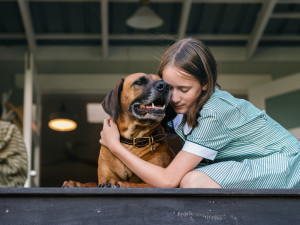When Your Dog Gets Alzheimer’s
For dogs with Alzheimer’s, confusion may reign as light falls.

Share Article
Recently, as the days shorten and the curtain of light falls earlier — at four o’clock, now three — Fromer, our 15-year-old Yorkie, goes bonkers. It’s as if the dark sets him off. Now he’s on the floor between my husband and myself, and his ballistic barking drowns out even the roar of the surf. By accident, I stumbled on a Newsweek about providing care to people with Alzheimer’s and the symptoms reminded me of my pup.
Does my dog have Alzheimer’s? Like a young child squalling over a bogeyman only he can see, at night Fromer got spooked. I switch on every light inside and out. He seems to calm down, but he is licking his paws so feverishly they will be raw if he keeps it up. His tommy-gun barking starts again. Night has turned him into Fromster-the-terrorist-terrier, an impossible-to-please elderly relative.
When I originally mentioned these symptoms to our vet, I didn’t get much satisfaction. “Maybe it’s neurological, or he’s cold, or it might be his eyesight,” said the vet. He reminded me that Fromer’s eyes were failing, making it harder for him to see when the light goes. He didn’t offer any therapeutic help to deal with the situation. So, our days were OK; the evenings were something else.
Can dogs get Alzheimer’s?
The article described how Alzheimer’s patients can become increasingly agitated at the end of the day, and how light is especially important to them in the late afternoon and early evening. Although Fromer hadn’t been diagnosed with Alzheimer’s — dogs also suffer from dementia and Alzheimer’s — the early nights of winter had brought on a behavior in my dog that exactly matched the symptoms of some Alzheimer’s patients.

Now I had a name for what I’d been observing. And a definition: According to Harvard Medical School, Department of Psychiatry, Alzheimer’s patients get recurring confusion and increased agitation in the late afternoon or early evening.
Understanding Alzheimer’s in dogs.
A half-dozen vets I have spoken with since then say they have never come across Alzheimer’s in veterinary literature. They offer replies similar to Dr. Allen M. Schoen’s, D.V.M., author of Kindred Spirits, “I am not familiar with the syndrome.”
Until I reach Dr. Nicholas Dodman, DVM, Director of the Behavior Clinic at Tufts University School of Veterinary Medicine. Dr. Dodman says, “I think you’ve struck on something.”
He explains that this behavior has been recognized but under the global term of sleep disturbance, which is one-quarter of the diagnostic criteria for canine Alzheimer’s. “Did Fromer have canine Alzheimer’s?” asks Dodman. “I would say from what you’ve told me — I never examined him — almost certainly, yes. Since sundowning is a part of Alzheimer’s in people, why wouldn’t it be in dogs as well?”
Johnny Hoskins, a small-animal internal medicine consultant with a specialty in geriatrics and pediatrics, agrees. “I believe dogs go through similar changes as humans as they age.” Dr. Hoskins explains there are certain triggers in older animals when they start having behavioral–mental changes. “In your animal, the trigger just happened to be when it was getting dark.”
Diagnosing Alzheimer’s in Dogs
Here is a simple acronym that can be used to diagnose canine Alzheimer’s: D.I.S.H.
[D] Disorientation: Getting stuck behind furniture, trying to get out the wrong side of a door, or appearing confused
[I] Altered social interactions: Dogs appear out of it, don’t respond as well to commands
[S] Sleep disturbances: Increased sleep during the day and decreased sleep at night, pacing, unexplained restlessness, especially in the evening or at night
[H] House-soiling: Increased accidents around the house
Dr. Dodman says this is the first time he’s heard of this association with dogs and the day/ night junction. He thinks it’s helpful because it adds another layer of detail to nocturnal disturbance syndrome. “It makes it easier for people to recognize and it’s a very clear-cut sign: As light is fading, some dogs — not all dogs — because not all dogs do everything with any disease, but some dogs with canine Alzheimer’s may, when light falls, become even more confused, and upset, and that can lead to this hysterical behavior: barking, pacing, inconsolability. Sundowning. I think that’s a very nice addition to the canine Alzheimer’s syndrome, which previously was just painted as a late-night, throughout the night, problem.”
Dr. Dodman explains that vets don’t have a good handle in this area. “They know there are sleep disturbances. But what precisely are they? Vets think that means when the owner goes to sleep at night the dog wakes up and barks and paces. Sundowning makes it more subtle, and more akin to the human syndrome, and it sounds perfectly reasonable.”
Now that we have a definition and a basis for diagnosis, is there a treatment in the canine population? Dr. Hoskins cautions that since there are so many neurotransmitters in the brain, a pet parent should not expect that one single medication will handle all the behavioral-mental changes in their animal. It’s way too late for Monday morning quarterbacking with Fromer, but perhaps others who are currently caretaking an elderly dog will find that these medical suggestions can make sundowning more understandable and less of a downer.
How to help your aging pup:
One antidote to sundowning is increasing the light to eliminate frightening shadows. Except increased illumination only helps patients with intact vision.
Treating the symptoms
Phototherapy: flooding the area with light; this appears to work if the patient doesn’t have vision loss
Buspirone, trade name Buspar: mild, anti-anxiety drug
Natural, holistic options: for calming—acupressure, and herbs such as kava and valerian
Treating the underlying medical condition
Deprenyl, trade name Anipryl: used to treat canine Alzheimer’s. In a third of the cases there is a dramatic turnaround; a third improve quite well; but, in a third it doesn’t work. When it is effective, there is a six-month limit to its effectiveness.
Jo Giese
Jo Giese is an award-winning radio journalist, author, teacher, community activist, and global traveler.
Related articles
![Young girl hugging an older dog on porch]()
How to Recognize and Treat Canine Dementia
Learn about the signs, symptoms, and treatments.
![Woman with arm tattoos and wearing a black t-shirt stretching out the back legs of a Shiba Inu dog laying on a dark green mat]()
Does Your Dog Need a Massage?
Help your dog stay fit and flexible with these stretch techniques by a certified pet strength and conditioning specialist.
![A German Shepherd Puppy sitting on a pink couch with head tilted]()
Call Alfred Hitchcock — Can Dogs Get Vertigo?
Learn the signs to look out for this condition.
![A dog resting its face on a wooden table.]()
Do Dogs Grieve When Other Dogs Die?
A study confirms our pets can have heartbreaking reactions to the loss of a canine companion.





